3COM 2226 PLUS User Manual

Baseline Switch
2226 Plus
User Guide
Installationsanleitung
3C16475CS
www.3com.com
Part No. 10015240 Rev. AA
Published August 2006
3Com Corporation • 350 Campus Drive • Marlborough • MA USA 01752-3064
Copyright © 2006, 3Com Corporation. All rights reserved. No part of this documentation may be reproduced in any form or by any means or used to make any derivative work (such as translation, transformation, or adaptation) without written permission from 3Com Corporation.
3Com Corporation reserves the right to revise this documentation and to make changes in content from time to time without obligation on the part of 3Com Corporation to provide notification of such revision or change.
3Com Corporation provides this documentation without warranty, term, or condition of any kind, either implied or expressed, including, but not limited to, the implied warranties, terms or conditions of merchantability, satisfactory quality, and fitness for a particular purpose. 3Com may make improvements or changes in the product(s) and/or the program(s) described in this documentation at any time.
If there is any software on removable media described in this documentation, it is furnished under a license agreement included with the product as a separate document, in the hard copy documentation, or on the removable media in a directory file named LICENSE.TXT or !LICENSE.TXT. If you are unable to locate a copy, please contact 3Com and a copy will be provided to you.
UNITED STATES GOVERNMENT LEGEND
If you are a United States government agency, then this documentation and the software described herein are provided to you subject to the following:
All technical data and computer software are commercial in nature and developed solely at private expense. Software is delivered as “Commercial Computer Software” as defined in DFARS 252.227-7014 (June 1995) or as a “commercial item” as defined in FAR 2.101(a) and as such is provided with only such rights as are provided in 3Com’s standard commercial license for the Software. Technical data is provided with limited rights only as provided in DFAR 252.227-7015 (Nov 1995) or FAR 52.227-14 (June 1987), whichever is applicable. You agree not to remove or deface any portion of any legend provided on any licensed program or documentation contained in, or delivered to you in conjunction with, this User Guide.
Unless otherwise indicated, 3Com registered trademarks are registered in the United States and may or may not be registered in other countries.
3Com, 3Com Express, 3Com Guardian and the 3Com logo are registered trademarks of 3Com Corporation.
IEEE and 802 are registered trademarks of the Institute of Electrical and Electronics Engineers, Inc. Intel is a registered trademark of Intel Corporation. Windows, and Windows NT are registered trademarks of Microsoft Corporation. Xerox is a registered trademark of Xerox Corporation. UNIX is a registered trademark in the United States and other countries, licensed exclusively through X/Open Company, Ltd.
All other company and product names may be trademarks of the respective companies with which they are associated.
ENVIRONMENTAL STATEMENT
It is the policy of 3Com Corporation to be environmentally-friendly in all operations. To uphold our policy, we are committed to:
■Establishing environmental performance standards that comply with national legislation and regulations.
■Conserving energy, materials and natural resources in all operations.
■Reducing the waste generated by all operations. Ensuring that all waste conforms to recognized environmental standards. Maximizing the recyclable and reusable content of all products.
■Ensuring that all products can be recycled, reused and disposed of safely.
■Ensuring that all products are labelled according to recognized environmental standards.
■Improving our environmental record on a continual basis.
End of Life Statement
3Com processes allow for the recovery, reclamation and safe disposal of all end-of-life electronic components.
Regulated Materials Statement
3Com products do not contain any hazardous or ozone-depleting material.
Environmental Statement about the Documentation
The documentation for this product is printed on paper that comes from sustainable, managed forests; it is fully biodegradable and recyclable, and is completely chlorine-free. The varnish is environmentally-friendly, and the inks are vegetable-based with a low heavy-metal content.

CONTENTS
ABOUT THIS GUIDE
Conventions 7
Documentation Comments 8
Product Registration 8
Checking for Correct Operation 18
Using SFP Tranceivers |
19 |
|
Approved SFP Transceivers |
19 |
|
Inserting an SFP Transceiver |
19 |
|
Removing an SFP Transceiver |
20 |
|
Performing Spot Checks |
21 |
|
1 |
INTRODUCING THE BASELINE SWITCH |
3 |
|
|
Overview of the Baseline Switch 9 |
CONNECTING TO THE WEB INTERFACE |
|
|
Features and Capabilities 9 |
|
Requirements for Accessing the Web Interface 23 |
|
Autosensing of MDI/MDIX Connections 9 |
|
Running the Discovery Application |
23 |
||||||
|
Autonegotiating 10/100 Mbps Ports |
9 |
|
Logging On to the Web Interface |
25 |
|||||
|
Gigabit Combo Ports (RJ-45/SFP) 9 |
|
|
Navigating the Web Interface |
26 |
|
||||
|
Physical Features |
10 |
|
|
|
Menu |
26 |
|
|
|
|
Front Panel |
10 |
|
|
|
Buttons |
29 |
|
|
|
|
Rear Panel |
13 |
|
|
|
Port Status 29 |
|
|
|
|
|
Package Contents 14 |
|
|
|
Accessing the Interface Without Using Discovery 30 |
|||||
|
|
|
|
|
|
DHCP Assigned IP Address |
30 |
|
||
2 |
INSTALLING THE SWITCH |
|
|
|
Manually Assigned (Static) IP Address 30 |
|||||
|
Before You Begin |
15 |
|
|
4 |
|
|
|
|
|
|
|
|
CONFIGURING THE SWITCH |
|
|
|||||
|
Positioning the Switch 15 |
|
|
|
|
|||||
|
Rack-Mounting or Free-Standing |
16 |
|
|
Configuration Overview |
31 |
|
|
||
|
Using the Mounting Kit 16 |
|
|
|
Device Summary Information |
31 |
|
|||
|
Montagesatz Anweisungen |
17 |
|
|
Administration Settings |
33 |
|
|
||
|
Placing Units On Top of Each Other |
17 |
|
Modifying the IP Address Settings 33 |
||||||
|
Supplying Power to the Switch |
18 |
|
|
Automatic IP Configuration |
33 |
||||

IP Setup |
34 |
|
|
|
|
Backup Configuration |
35 |
||||
Restore Configuration |
35 |
||||
Firmware Upgrade |
36 |
||||
Initialize |
37 |
|
|
|
|
Reboot |
37 |
|
|
|
|
System Access |
|
38 |
|
|
|
System Time |
40 |
|
|
||
SNMP |
40 |
|
|
|
|
Configuring VLANs |
|
42 |
|
||
VLAN |
43 |
|
|
|
|
Forwarding Tagged/Untagged Frames 47 |
|||||
Sample VLAN Configurations 47 |
|||||
Spanning Tree |
|
49 |
|
|
|
IGMP Snooping |
51 |
|
|||
IGMP Query |
51 |
|
|
||
Broadcast Storm |
51 |
|
|||
Configuring Port Settings |
53 |
||||
Administration |
|
53 |
|
||
Speed/Duplex for 1000 Mbps Connections 55 |
|||||
Link Aggregation |
56 |
|
|||
Spanning Tree per Port |
58 |
||||
Port Mirroring |
|
61 |
|
|
|
Statistics |
62 |
|
|
|
|
QoS VoIP Traffic Settings |
|
62 |
|||
Security 65 |
|
|
|
|
|
RADIUS Client |
|
65 |
|
|
|
802.1X Settings |
67 |
|
|||
Monitoring |
70 |
|
|
|
|
Address Table |
|
70 |
|
|
|
Cable Diagnostics |
70 |
|
|||
5 |
TROUBLESHOOTING |
|
|
|
|
|
Resetting to Factory Defaults |
73 |
|||
|
Forgotten Password |
74 |
|
||
|
Forgotten Static IP Address |
74 |
|||
|
Solving LED Issues |
74 |
|
|
|
|
If the Problem Persists |
76 |
|
||
A |
|
||||
OBTAINING SUPPORT FOR YOUR PRODUCT |
|||||
|
Register Your Product |
77 |
|
||
|
Purchase Value-Added Services 77 |
||||
|
Troubleshoot Online |
77 |
|
||
|
Access Software Downloads |
77 |
|||
|
Telephone Technical Support and Repair 78 |
||||
|
Contact Us |
78 |
|
|
|
B |
|
|
|||
TECHNICAL INFORMATION |
|
||||
|
Related Standards |
81 |
|
|
|
|
Environmental |
81 |
|
|
|
|
Physical |
81 |
|
|
|
|
Electrical |
81 |
|
|
|
C |
|
|
|
||
SAFETY INFORMATION |
|
|
|||
|
Important Safety Information |
83 |
|||

GLOSSARY
REGULATORY NOTICES
INDEX
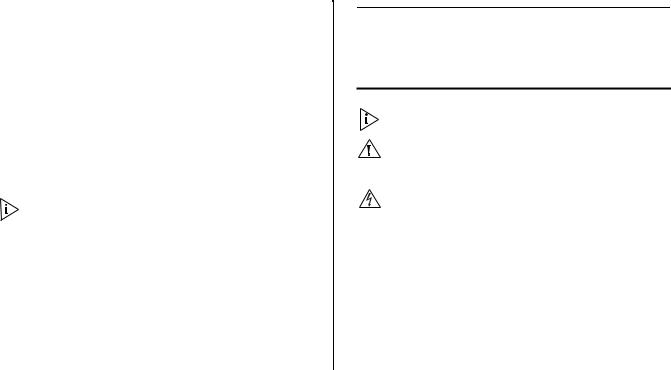
ABOUT THIS GUIDE
This guide describes how to install your 3Com Switch and perform initial management configurations.
This guide is intended for use by those responsible for installing and setting up network equipment; consequently, it assumes a basic working knowledge of LANs (Local Area Networks).
Diese Anleitung ist fur die Benutzung durch Netzwerkadministratoren vorgesehen, die fur die Installation und das einstellen von Netzwerkkomponenten verantwortlich sind; sie setzt Erfahrung bei der Arbeit mit LANs (Local Area Networks) voraus.
If release notes are shipped with your product and the information there differs from the information in this guide, follow the instructions in the release notes.
Most user guides and release notes are available in Adobe Acrobat Reader Portable Document Format (PDF) or HTML on the 3Com World Wide Web site:
www.3com.com
Conventions
Table 1 and Table 2 list conventions that are used throughout this guide.
Table 1 Notice Icons
Icon |
Notice Type |
Description |
|
|
|
|
Information note |
Information that describes |
|
|
important features or instructions |
|
|
|
|
Caution |
Information that alerts you to |
|
|
potential loss of data or potential |
|
|
damage to an application, system, |
|
|
or device |
|
|
|
|
Warning |
Information that alerts you to |
|
|
potential personal injury |
|
|
|

8 |
ABOUT THIS GUIDE |
|
|
|
Table 2 Text Conventions |
||
|
|
||
Convention |
Description |
||
|
|
||
The words “enter” |
When you see the word “enter” in this |
||
and “type” |
guide, you must type something, and then |
||
|
|
press Return or Enter. Do not press Return |
|
|
|
or Enter when an instruction simply says |
|
|
|
“type.” |
|
|
|
||
Keyboard key names |
If you must press two or more keys |
||
|
|
simultaneously, the key names are linked |
|
|
|
with a plus sign (+). Example: |
|
|
|
|
Press Ctrl+Alt+Del |
|
|
||
Words in italics |
Italics are used to: |
||
|
|
■ |
Emphasize a point. |
|
|
■ |
Denote a new term at the place where it |
|
|
|
is defined in the text. |
|
|
■ |
Identify menu names, menu commands, |
|
|
|
and software button names. Examples: |
From the Help menu, select Contents.
Click OK.
Documentation Comments
Your suggestions are very important to us. They will help make our documentation more useful to you. Please e-mail comments about this document to 3Com at:
pddtechpubs_comments@3com.com
Please include the following information when contacting us:
■Document title
■Document part number (on the title page)
■Page number (if appropriate)
Example:
■Baseline Switch 2226 Plus User Guide
■Part number: 10015240
■Page 25
Please note that we can only respond to comments and questions about 3Com product documentation at this e-mail address. Questions related to technical support or sales should be directed in the first instance to your network supplier.
Product Registration
You can now register your Baseline Switch on the 3Com Web site to receive up-to-date information on your product:
http://esupport.3com.com

1 |
INTRODUCING THE BASELINE SWITCH |
This chapter provides an overview of the features and capabilities of the 3Com Baseline Switch 2226 Plus. It also identifies the contents of the Switch package and helps you get to know the physical features of the device.
Overview of the Baseline Switch
The 3Com® Baseline Switch 2226 Plus is a versatile, easy-to-use unmanaged switch. It is ideal for users who want the high-speed performance of 10/100 switching with the added functionality of Gigabit fiber links, but do not need sophisticated management capabilities. The Switch is shipped ready for use. No configuration is necessary.
Features and Capabilities
The Switch has 24 shielded RJ-45, 10/100 Mbps auto-negotiating ports and 2 Gigabit combo ports (which comprised of a RJ-45 port and a Small Form Factor Pluggable (SFP) transceiver slot) on the front panel for easy, flexible connection to fiber-based Gigabit media.
Autosensing of MDI/MDIX Connections
All ports on the Switch can autosense both medium dependent interface (MDI) and medium dependent interface crossover (MDIX) connections. This allows you to connect network devices to each port using either a normal straight-through TP (twisted pair) cable or a ‘crossover’ TP cable.
Any port can therefore be used to connect to another switch port, server, or workstation without additional configuration.
Autonegotiating 10/100 Mbps Ports
Each 10/100 Mbps port automatically determines the speed and duplex mode of the connected equipment and provides a suitable switched connection. The 10/100 Mbps ports can operate in either half-duplex or full-duplex mode.
Gigabit Combo Ports (RJ-45/SFP)
The 2 Gigabit combo ports support fiber Gigabit Ethernet short-wave (SX) and long-wave (LX) SFP transceivers in any combination. This offers you the flexibility of using SFP transceivers to provide connectivity between the Switch and a 1000 Mbps core network.
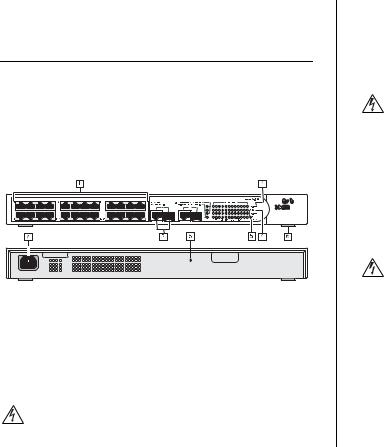
10 |
INTRODUCING THE BASELINE SWITCH |
When an SFP port is in operation, the corresponding 1000BASE-T port is disabled. The 1000 Mbps connections can only operate in full duplex mode.
Physical Features
Figure 1 shows the front and rear panels of the Switch. The numbers in this diagram refer to numbered sections in “Front Panel” on page 10 and “Rear Panel” on page 13.
Figure 1 Front and Rear Panels
Front Panel
The front panel of the Switch contains a series of indicator lights (LEDs) that help describe the state of various networking and connection operations.
(1) RJ-45 10/100 Ports
WARNING: RJ-45 Ports. These are shielded RJ-45 data sockets. They cannot be used as standard traditional telephone sockets, or to connect the unit to a
traditional PBX or public telephone network. Only connect RJ-45 data connectors, network telephony systems, or network telephones to these sockets. Either shielded or unshielded data cables with shielded or unshielded jacks can be connected to these data sockets.
AVERTISSEMENT: Points d’accès RJ-45. Ceux-ci sont protégés par des prises de données. Ils ne peuvent pas être utilisés comme prises de téléphone conventionnelles standard, ni pour la connection de l’unité à un réseau téléphonique central privé ou public. Raccorder seulement connecteurs de données RJ-45, systèmes de réseaux de téléphonie ou téléphones de réseaux à ces prises.
Il est possible de raccorder des câbles protégés ou non protégés avec des jacks protégés ou non protégés à ces prises de données.
WARNHINWEIS: RJ-45-Porte. Diese Porte sind geschützte Datensteckdosen. Sie dürfen weder wie normale traditionelle Telefonsteckdosen noch für die Verbindung der Einheit mit einem traditionellem privatem oder öffentlichem Telefonnetzwerk gebraucht werden. Nur RJ-45-Datenanscluße, Telefonnetzsysteme or Netztelefone an diese Steckdosen anschließen. Entweder geschützte oder ungeschützte Buchsen dürfen an diese Datensteckdosen angeschlossen werden.
The Switch has 24 10/100 Mbps auto-negotiating ports. Each port supports automatic MDI/MDI-X detection and
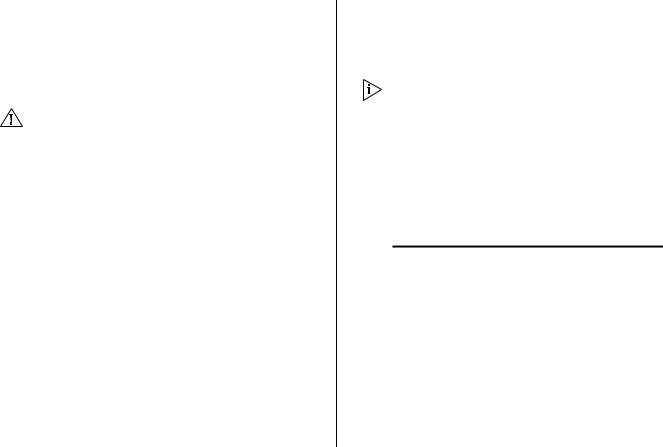
can be connected to either a 10BASE-T, or 100BASE-TX device.
For each port, the speed and duplex mode (half duplex or full duplex for 10BASE-T and 100BASE-TX) are automatically determined by the capabilities of the connected device.
CAUTION: The Switch supports full duplex auto-negotiation. If auto-negotiation is disabled for 1000BASE-T, then the Switch uses the forced-mode default of 100 full duplex mode. If the connected device does not support auto-negotiation, the Switch will operate in half duplex mode (even if the attached device is operating in full duplex mode). In such a configuration, you may notice some degradation of network performance. 3Com recommends that you use devices that are capable of auto-negotiation (and that you ensure that auto-negotiation is enabled, if it is a configurable option).
(2) Gigabit Combo Ports (RJ-45/SFP)
The Gigabit combo ports (RJ-45/Small Form Factor Pluggable (SFP) ports) are numbered 25 and 26. If the link connections on the SFP ports are active, the associated RJ-45 port of the same number is disabled.
The two SFP ports support fiber Gigabit Ethernet short-wave (SX) and long-wave (LX) SFP transceivers in any combination. This offers you the flexibility of using SFP transceivers to provide connectivity between the Switch and remote 1000 Mbps workgroups or to create
Physical Features |
11 |
a high-capacity aggregated link backbone connection. The default active port is the SFP port. The selection of active ports can be configured via the Web interface.
The SFP port supports full duplex mode only.
SFP ports are numbered 25 and 26 on the Switch. When an SFP port is active it has priority over the 10/100/1000 port of the same number. The corresponding 10/100/1000 port is disabled when an SFP link connection is active.
(3) Link/Activity Status LEDs
The first (top) and third row of LEDs, which are colored yellow or green, show the link, activity and speed status of the related ports:
10/100/1000BASE-T Ports
Status |
Meaning |
|
|
Green |
The link is operating at 1000 Mbps. |
Yellow |
The link is operating at 10 or 100 Mbps. |
Flashing |
Packets are being received or transmitted on the |
Green |
port at 1000 Mbps. |
Flashing |
Packets are being received or transmitted on the |
Yellow |
port at 10 or 100 Mbps. |

12 |
INTRODUCING THE BASELINE SWITCH |
||
|
|
|
|
|
Off |
The link has not been established, either nothing |
|
|
|
is connected to the port, or there is a problem: |
|
|
|
■ |
Check that the attached device is powered |
|
|
|
on. |
|
|
■ |
Check that the cable or fiber is the correct |
|
|
|
type and is not faulty. |
|
|
■ |
For fiber connections, ensure that the receive |
|
|
|
(RX) and transmit (TX) cable connectors are |
|
|
|
not swapped. |
If these checks do not identify the cause of the problem, it may be that the unit or the device connected to the port is faulty. Contact your supplier for further advice.
10/100BASE-TX Ports
Status |
Meaning |
|
|
Green |
The link is operating at 100 Mbps. |
Yellow |
The link is operating at 10 Mbps. |
Flashing |
Packets are being received or transmitted on the |
Green |
port at 100 Mbps. |
Flashing |
Packets are being received or transmitted on the |
Yellow |
port at 10 Mbps. |
Off |
The link has not been established, either nothing |
|
is connected to the port, or there is a problem: |
■Check that the attached device is powered on.
■Check that the cable or fiber is the correct type and is not faulty.
■For fiber connections, ensure that the receive (RX) and transmit (TX) cable connectors are not swapped.
If these checks do not identify the cause of the problem, it may be that the unit or the device connected to the port is faulty. Contact your supplier for further advice.
(4) Duplex Status LEDs
The second and fourth (bottom) row of Status LEDs, which are colored yellow (for duplex) or green (for module active), show the duplex status of the related ports:
10/100/1000BASE-T Ports
Status |
Meaning |
|
|
Yellow |
The port is operating in full duplex mode. |
Off |
The port is operating in half duplex mode. |
|
|
1000BASE-T only operates in full duplex mode. 10/100BASE-TX can be in half or full duplex mode.
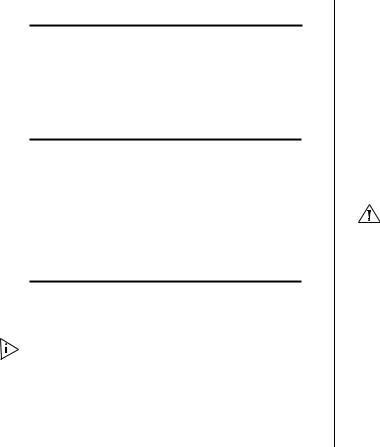
Gigabit Combo Ports
Status |
Meaning |
|
|
Green |
SFP is inserted in the slot. |
Off |
No SFP in the slot. |
|
|
(5) Power LED
The Power LED shows the power status of the Switch.
Status |
Meaning |
|
|
Green |
The unit is powered on and ready for use. |
Yellow |
Internal power, POST, or loopback test has |
|
failed. Switch is in fail-safe mode. |
Off |
The unit is not receiving power. |
■Check that the power cord is connected correctly.
■If the unit still does not operate, contact your supplier.
(6)Self-adhesive Pads
The unit is supplied with four self-adhesive rubber pads.
Do not apply the pads if you intend to rack mount the unit.
If the unit is to be part of a free-standing stack, apply the pads to each marked corner area on the underside of the unit. Place the unit on top of the lower unit, ensuring that the pads locate with the recesses of the lower unit.
Physical Features |
13 |
Rear Panel
The rear panel of the Switch contains a power supply socket and a recovery button.
(7) Power Supply
The Switch automatically adjusts to the supply voltage. Only use the power cord that is supplied with the unit.
(8) Recovery Button
The recovery button reinitializes the Switch. This returns the Switch to the factory default settings if, for example, you have forgotten the default IP address, or forgotten your user name or password.
CAUTION: 3Com recommends that you back up your configuration settings before you recover the Switch, otherwise your configuration may be lost. Refer to “Resetting to Factory Defaults” on page 73 for details.

14 |
INTRODUCING THE BASELINE SWITCH |
Package Contents
Before installing and using the Switch, verify that your Switch package is complete. The Switch comes with:
■One power cord
■Four standard height, self-adhesive rubber pads
■One mounting kit
■Installation CD
■This User Guide
■Warranty flyer
The Switch is powered from the AC supply.
If any of the above items are damaged or missing, contact your 3Com network supplier immediately.

2 |
INSTALLING THE SWITCH |
This chapter contains information that you need to install and set up the Switch. It covers the following topics:
■Before You Begin
■Positioning the Switch
■Rack-Mounting or Free-Standing
■Supplying Power to the Switch
■Using SFP Transceivers
■Performing Spot Checks
Before You Begin
WARNING: Safety Information. Before installing or removing any components from the Switch or carrying out any maintenance procedures, read the safety information provided in Appendix C of this guide.
AVERTISSEMENT: Consignes de Sécurité. Avant d'installer ou d'enlever tout composant du Switch ou d'entamer une procédure de maintenance, lisez les informations relatives à la sécurité qui se trouvent dans l'Appendice C (Appendix C) de ce guide.
WARNHINWEIS: Sicherheitsinformationen. Bevor Sie Komponenten aus dem Switch entfernen oder dem Switch hinzufuegen oder Instandhaltungsarbeiten verrichten, lesen Sie die Sicherheitsanweisungen, die in Anhang C (Appendix C) in diesem Handbuch aufgefuehrt sind.
ADVERTENCIA: Información de Seguridad. Antes de instalar o extraer cualquier componente del product o de realizar tareas de mantenimiento, debe leer la información de seguridad facilitada en el Apéndice C (Appendix C) de esta guía del usuario.
AVVERTENZA: Informazioni di Sicurezza. Prima di installare o rimuovere qualsiasi componente dal product o di eseguire qualsiasi procedura di manutenzione, leggere le informazioni di sicurezza riportate nell'Appendice C (Appendix C) della presente guida per l'utente.
Positioning the Switch
The Switch is suitable for use in an office environment where it can be free-standing or mounted in a standard 19-inch equipment rack.
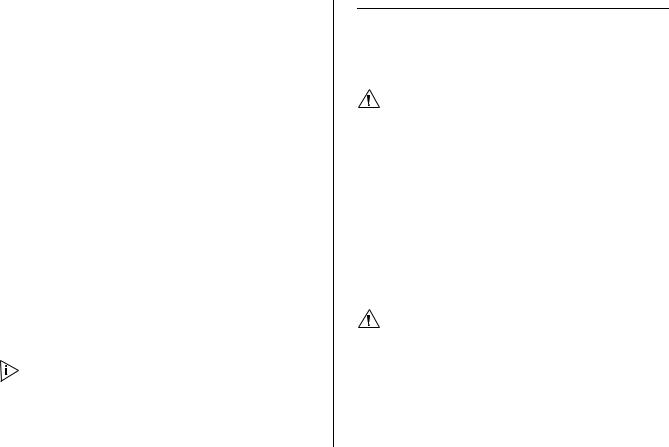
16 |
INSTALLING THE SWITCH |
Alternatively, the Switch can be rack-mounted in a wiring closet or equipment room. A mounting kit, containing two mounting brackets and four screws, is supplied with the Switch.
When deciding where to position the Switch, ensure that:
■It is accessible and cables can be connected easily.
■Cabling is away from sources of electrical noise. These include lift shafts, microwave ovens, and air conditioning units. Electromagnetic fields can interfere with the signals on copper cabling and introduce errors, therefore slowing down your network.
■Water or moisture cannot enter the case of the unit.
■Air flow around the unit and through the vents on the side of the case is not restricted (3Com recommends that you provide a minimum of 25 mm (1 in.) clearance).
■The air is as free from dust as possible.
■Temperature operating limits are not likely to be exceeded. It is recommended that the unit is installed in a clean, air conditioned environment.
It is always good practice to wear an anti-static wrist strap when installing network equipment, connected to a ground point. If one is not available, try to keep in contact with a grounded rack and avoid touching the unit's ports and connectors, if possible. Static discharge can cause reliability problems in your equipment.
Rack-Mounting or Free-Standing
The unit can be mounted in a 19-inch equipment rack using the mounting kit or it can be free standing. Do not place objects on top of the unit or stack.
CAUTION: If installing the Switch in a free-standing stack of different size Baseline or Superstack 3 units, the smaller units must be installed above the larger ones. Do not have a free-standing stack of more than six units.
Using the Mounting Kit
The Switch is supplied with two mounting brackets and four screws. These are used for rack mounting the unit. When mounting the unit, you should take note of the guidelines given in “Positioning the Switch” on
page 15.
The Switch is 1U (1.7 inches) high and will fit in a standard 19-inch rack.
CAUTION: Disconnect all cables from the unit before continuing. Remove the self-adhesive pads from the underside of unit, if already fitted.
To rack-mount the Switch:
1Place the unit the right way up on a hard, flat surface with the front facing towards you.
2Locate a mounting bracket over the mounting holes on one side of the unit.
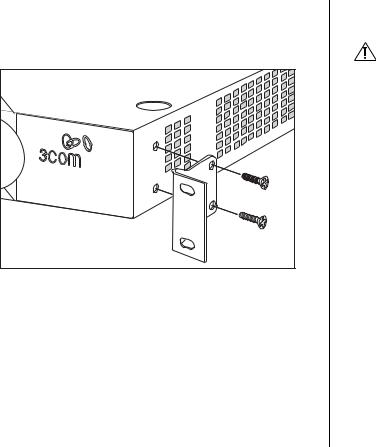
3Insert the two screws supplied in the mounting kit and fully tighten with a suitable screwdriver.
Figure 2 Rack Mounting the Unit
4Repeat steps 2 and 3 for the other side of the unit.
5Insert the unit into the 19-inch rack and secure with suitable screws (not provided).
6Reconnect the cables.
Montagesatz Anweisungen
Der Switch wird mit zwei Halterungen und vier Schrauben geliefert. Diese werde für den Einbau in einen Baugruppenträger benutzt. Bei der Montage der Baugruppe beachten Sie die Anweisungen aus “Positioning the Switch” on page 15.
Rack-Mounting or Free-Standing |
17 |
Der Switch ist eine Baueinheit hoch und passt in einen Standard 19'' (Zoll) Baugruppenträger.
ACHTUNG: Entfernen Sie alle Kabel, bevor Sie fortfahren. Entfernen Sie die selbstklebenden Polster (Füße) von der Unterseite der Baugruppe, falls diese bereits angebracht sind.
1Plazieren Sie die Baugruppe aufrecht auf einer harten, ebenen Fläche mit der Vorderseite zu Ihnen.
2Ordnen Sie eine der Halterungen über den Löchern an der Seite der Baugruppe an.
3Stecken Sie zwei der mitgelieferten Schrauben in die Löcher und drehen Sie diese mit einem geeigneten Schraubendreher fest.
4Widerholen Sie letzten beiden Schritte auf der anderen Seite der Baugruppe.
5Führen Sie die Baugruppe in den 19" (Zoll) Baugruppenträger ein und sichern sie die Baugruppe mit geeigneten Schrauben. (Nicht im Lieferumfang enthalten).
6Schließen Sie alle Kabel wieder an.
Placing Units On Top of Each Other
If the Switch units are free-standing, up to six units can be placed one on top of the other. If you are mixing a variety of Baseline and SuperStack units, the smaller units must be positioned at the top.
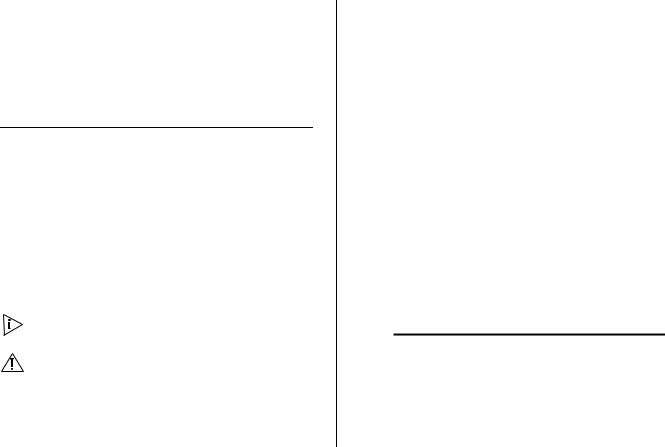
18 |
INSTALLING THE SWITCH |
If you are placing Switch units one on top of the other, you must use the self-adhesive rubber pads supplied. Apply the pads to the underside of each Switch, sticking one in the marked area at each corner.
Place the Switch units on top of each other, ensuring that the pads of the upper unit line up with the recesses of the lower unit.
Supplying Power to the Switch
Power problems can be the cause of serious failures and downtime in your network. Ensure that the power input to your system is clean and free from sags and surges to avoid unforeseen network outages. 3Com recommends that you install power conditioning, especially in areas prone to blackout, power dips and electrical storms.
The unit is intended to be grounded. Ensure it is connected to earth ground during normal use. Installing proper grounding helps to avoid damage from lightning and power surges.
Before powering on the Switch, verify that the network cables and the power cable are securely connected.
CAUTION: The Switch has no ON/OFF switch. The only way to power on and power off the Switch is by connecting and disconnecting the power cord. This is called “power cycling”.
To power on the Switch:
1Plug the power cord into the power socket on the rear panel of the Switch. Refer to “(7) Power Supply” on page 13 for more information.
2Plug the other end of the power cord into a power outlet.
When the Switch is powered on, the Power LED lights up. If the Power LED does not light up, refer to “(5) Power LED” on page 13 for more information.
Checking for Correct Operation
After you power on the Switch, it automatically performs a power-on self-test (POST). During POST, the Power LED on the front panel of the Switch flashes green.
When POST is complete, the Power LED turns green. If the Power LED turns yellow after POST, it means that POST failed and the Switch has entered fail-safe mode.
The following summarizes the possible colors for the Power LED after POST.
Status |
Meaning |
|
|
Green |
The unit is powered on and ready to use. |
Yellow |
Power-on self-test or loopback test failed. The |
|
Switch is in fail-safe mode. This can happen if a |
|
port or ports fail when the Switch was powered |
|
on. |
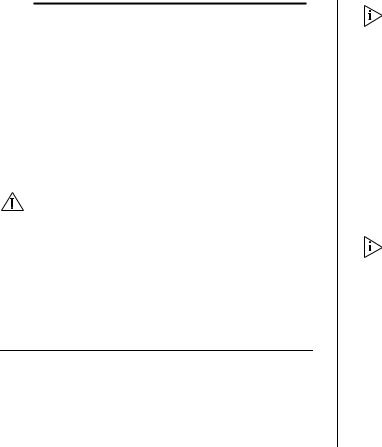
Off |
The unit is not receiving power: |
|
|
■ |
Verify that the power cord is connected cor- |
|
|
rectly, and then try powering on the Switch |
|
|
again |
|
■ |
If the Switch still does not operate, contact |
|
|
your 3Com network supplier |
|
|
|
If POST fails, try the following:
■Power off the Switch, and then power it on again. Check the Power LED and see if POST was successfully completed.
■Reset the Switch. See “Resetting to Factory Defaults” on page 73.
CAUTION: Resetting the Switch to its factory defaults erases all your settings. You will need to reconfigure the Switch after you reset it.
If these do not resolve the issue:
■Check the 3Com Knowledgebase for a solution. To visit the 3Com Knowledgebase Web site, start your Web browser, and then enter http://knowledgebase.3com.com.
■Contact your 3Com network supplier for assistance.
Using SFP Tranceivers
The following sections describe how to insert an SFP transceiver into an SFP slot.
Using SFP Tranceivers |
19 |
SFP transceivers are hot-insertable and hot-swappable. You can remove them from and insert them into any SFP port without having to power down the Switch.
Approved SFP Transceivers
The following list of approved SFP transceivers is correct at the time of publication:
■3CSFP91 SFP (SX)
■3CSFP92 SFP (LX)
To access the latest list of approved SFP transceivers for the Switch on the 3Com Web site, enter this URL into your Internet browser:
http://www.3com.com
3Com recommends using 3Com SFPs on the Switch. If you insert an SFP transceiver that is not supported, the Switch will not recognize it.
Inserting an SFP Transceiver
To be recognized as valid, the SFP transceiver must have the following characteristics:
■1000BASE-SX or 1000BASE-LX media type:
■1000BASE-SX SFP transceiver
Use this transceiver to connect the Switch directly to a multimode fiber-optic cable.
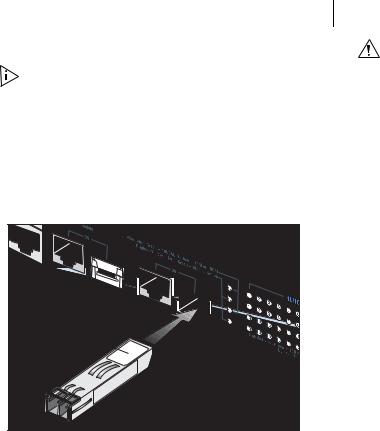
20INSTALLING THE SWITCH
■1000BASE-LX SFP transceiver
Use this transceiver to connect the Switch directly to a single mode fiber-optic cable or to multimode fiber using a conditioned launch cable.
If the SFP transceiver is faulty, it will not operate within the Switch. See “Troubleshooting” on page 73.
To activate the SFP port:
1Hold the transceiver so that the fiber connector is toward you and the product label is visible, as shown in Figure 3. Ensure the wire release lever is closed (in the upright position).
Figure 3 Inserting an SFP Transceiver
2Gently slide the transceiver into the SFP slot until it clicks into place.
CAUTION: SFP transceivers are keyed and can be properly inserted only one way. If the transceiver does not click when you insert it, remove it, turn it over, and reinsert it.
3Remove the plastic protective cover, if fitted.
4Connect the fiber cable.
5Attach a male duplex LC connector on the network cable into the duplex LC connector on the transceiver.
6Connect the other end of the cable to a device fitted with an appropriate Gigabit Ethernet connection.
7Check the Module Active LEDs on the front of the Switch to ensure that the SFP transceiver is operating correctly.
Removing an SFP Transceiver
Removing an SFP transceiver does not require powering off the Switch.
To remove an SFP transceiver:
1Disconnect the cable from the transceiver.
2Move the wire release lever downwards until it is pointing toward you.
3Pull the wire release lever toward you to release the catch mechanism.
The SFP transceiver should slide out easily.

Performing Spot Checks |
21 |
Performing Spot Checks
At frequent intervals, you should visually check the Switch. Regular checks can give you an early warning of a possible failure; any problems can then be attended to when there will be least effect on users.
3Com recommends periodically checking the items listed in Table 1.
Table 1 Items to Check
Cabling |
Check that all external cabling connections |
|
are secure and that no cables are pulled |
|
taut. |
Cooling fan |
Where possible, check that the cooling fan |
|
is operating by listening to the unit. The fan |
|
is fitted near to the front right hand side of |
|
the unit (when viewed from the front). |
|
|
If you experience any problems operating the Switch, refer to “Troubleshooting” on page 73.

22 |
INSTALLING THE SWITCH |

3 |
CONNECTING TO THE WEB INTERFACE |
The Switch has a built-in Web interface that you can use to set the admin password, change the IP address that is assigned to the Switch, and configure its advanced settings.
If you only want the Switch to function as a basic layer 2 switch, you do not need to access the Web interface and configure the Switch.
This chapter provides information on how the gain access to the Web interface using the Discovery application. It also introduces the menu items and buttons that are available on the Web interface.
The following topics are covered:
■Requirements for Accessing the Web Interface
■Running the Discovery Application
■Logging On to the Web Interface
■Navigating the Web Interface
■Accessing the Interface Without Using Discovery
Requirements for Accessing the Web Interface
To connect to the Web interface, you need the following:
■The Discovery application, which is included on 3Com Baseline Switch 2226 Plus CD-ROM that is supplied with your Switch
■A computer that is connected to the Switch and that has a Web browser
Running the Discovery Application
The 3Com Baseline Switch 2226 Plus CD-ROM contains, among others, the Discovery application.
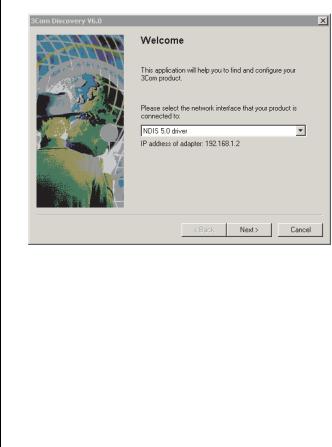
24 |
CHAPTER 3: CONNECTING TO THE WEB INTERFACE |
The Discovery application can be used for detecting and connecting to the Switch on the network. The application will launch a Web interface that provides the user with options to configure, modify, and upgrade the Switch.
To use Discovery to connect to the Web interface, do the following:
1On a computer that is connected to the Switch, insert the CD-ROM into its CD drive.
Discovery should start automatically. If it does not start automatically, go to the \Discovery folder on the CD-ROM, and then double-click
discovery.exe.
The Welcome screen of Discovery appears.
Figure 4 Welcome Screen of Discovery
2If the computer has multiple network adapters, select the adapter that connects the computer to the Switch, and then click Next.
If the computer has only one adapter, click
Next.
Discovery searches the network for 3Com devices. When detection is complete, the Discovered Devices screen displays detected network devices.
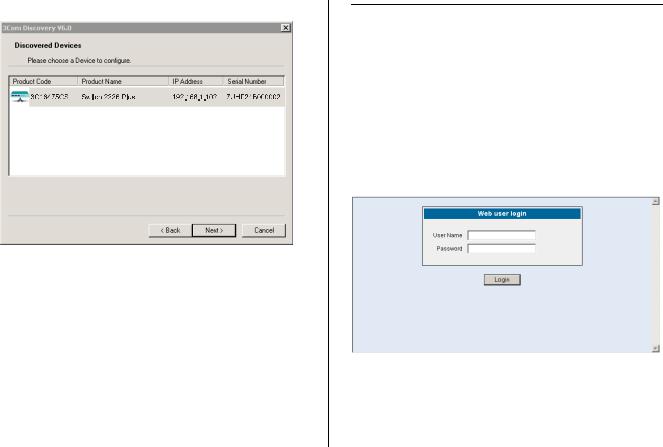
Figure 5 Discovered Devices Screen
3On the Discovered Devices screen, click
Baseline Switch 2226 Plus, and then click Next.
The Completing the 3Com Discovery Application screen appears.
4Click Finish.
The logon dialog box for the Web interface appears.
Logging On to the Web Interface |
25 |
Logging On to the Web Interface
After the Web interface loads in your Web browser, the first page that appears is the logon screen. On this screen, you need to enter the administration user name and password to gain access to the Web interface.
The logon screen also displays the IP address that the Switch is currently using.
Figure 6 Logon Dialog Box
To log on to the Web interface:
1In User name, type admin.
2Leave the Password field blank.
3Click OK.
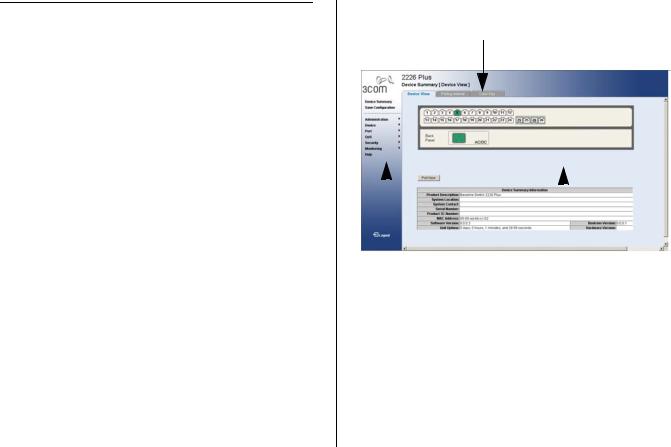
26 |
CHAPTER 3: CONNECTING TO THE WEB INTERFACE |
Navigating the Web Interface
The Web interface has been designed to enable you to easily perform advanced configuration tasks and view information about the Switch.
Menu
The menu is located on the left side of the Web interface. When you click an item on the menu, the related screen appears in the main part of the interface. Some menu items will give you sub-menu tabs to choose from.
Figure 7 Switch Screen Layout
Sub-Menu Tabs
|
|
|
|
|
|
|
|
|
Menu |
|
System |
|
Information |
||
|
|
|
|||||

Table 1 lists the available items on the menu.
Table 1 Available Menu Items
Menu Item |
Description |
|
|
|
|
Device Summary |
Contains tabs that allow you to: |
|
|
■ |
Provide a summary of the Switch’s |
|
|
basic settings and versions of current |
|
|
components. |
|
■ |
Set the polling interval in seconds. |
|
■ |
Display the description for each |
|
|
color coded port. |
Save Configuration |
Saves the Switch’s configuration. |
|
Administration |
Manages the device. |
|
IP Setup |
Allows you to setup, modify, or view |
|
|
the IP configuration parameters. |
|
Backup |
Allows you to backup the Switch’s |
|
Configuration |
configuration. |
|
Restore |
Allows you to restore a saved |
|
Configuration |
configuration. |
|
Firmware Upgrade |
Allows you to upgrade the current |
|
|
firmware via HTTP. |
|
Initialize |
Allows you to reset the Switch to |
|
|
factory default settings. |
|
Reboot |
Allows you to perform system reboot. |
|
|
|
|
Navigating the Web Interface |
27 |
Menu Item |
Description |
|
|
|
|
System Access |
Contains tabs that allow you to: |
|
|
■ |
Display user summary information. |
|
■ |
Create a new user. |
|
■ |
Modify existing users. |
|
■ |
Remove existing users. |
System Time |
Allows you to set the system time. |
|
SNMP |
Contains tabs that allow you to: |
|
|
■ |
Display SNMP summary. |
|
■ |
Add community strings. |
|
■ |
Remove community strings. |
Device |
Configures the device. |
|
VLAN |
Contains tabs that allow you to: |
|
|
■ |
Create a VLAN. |
|
■ |
Modify a VLAN. |
|
■ |
Modify VLAN membership for a |
|
|
port. |
|
■ |
Rename a VLAN. |
|
■ |
Remove a VLAN. |
|
■ |
Display VLAN membership for a |
|
|
port. |
|
■ |
Display VLAN information. |
Spanning Tree |
Allows you to configure a Spanning |
|
|
Tree Protocol. |
|
|
|
|

28 CHAPTER 3: CONNECTING TO THE WEB INTERFACE
Menu Item |
Description |
|
|
|
|
IGMP Snooping |
Allows you to enable or disable IGMP |
|
|
snooping. |
|
IGMP Query |
Allows you to enable or disable IGMP |
|
|
query mode. |
|
Broadcast Storm |
Allows you to enable or disable rate |
|
|
limiting. |
|
Port |
Configures the ports. |
|
Administration |
Contains tabs that allow you to: |
|
|
■ Display selected port information for |
|
|
|
the entire Switch. |
|
■ |
Display individual port information. |
|
■ |
Modify the port settings. |
Link Aggregation |
Contains tabs that allow you to: |
|
|
■ |
Display link aggregation summary. |
|
■ |
Create an aggregation group. |
|
■ |
Modify the port memberships. |
|
■ |
Remove an aggregation group. |
Spanning Tree per Contains tabs that allow you to:
Port |
Display selected spanning tree |
■ |
|
|
information for every port. |
■ Display individual port spanning tree |
|
|
information. |
■ |
Modify the spanning tree settings |
|
for a port. |
|
|
Menu Item |
Description |
|
|
|
|
Port Mirroring |
Monitor traffic going in and out of |
|
|
ports. |
|
Statistics |
Display statistics for a selected port. |
|
QoS |
Configures QoS settings. |
|
VoIP Traffic Setting |
Contains tabs that allow you to: |
|
|
■ |
Display Voice VLAN summary. |
|
■ |
Configure Voice VLAN global |
|
|
settings. |
|
■ |
Configure Voice VLAN port settings. |
|
■ |
Display port information for Voice |
|
|
VLAN and Trunk details. |
|
■ |
Display OUI summary. |
|
■ |
Add or remove OUI. |
Security |
Configures security settings. |
|
Radius Client |
Contains tabs that allow you to: |
|
|
■ |
Display Radius Client information. |
|
■ Configure Radius Client settings and |
|
|
|
set authentication parameters. |
|
|
|

Menu Item |
Description |
|
|
|
|
802.1X Settings |
Contains tabs that allow you to: |
|
|
■ |
Display system authentication |
|
|
summary. |
|
■ |
Display detailed information per |
|
|
port. |
|
■ |
Configure system authentication |
|
|
settings. |
Monitoring |
Display Switch monitoring information. |
|
Address Table |
Displays MAC address table |
|
|
information for ports and VLANs. |
|
Cable Diagnostics |
Contains tabs that allow you to: |
|
|
■ |
Display selected cable diagnostics |
|
|
information for all ports. |
|
■ |
Display all cable diagnostics |
|
|
information for a single port. |
Help |
Displays 3Com contact information |
|
|
and describes how to use the online |
|
|
help system. |
|
Log Out |
Allows you to securely log off the Web |
|
|
interface. |
|
|
|
|
Navigating the Web Interface |
29 |
Buttons
Depending on the screen that is currently displayed, the following buttons may appear:
■Apply – Click to save and apply any changes that you have made
■Cancel – Click to discard any unsaved changes
■Help – Click to display the context-sensitive help information for the screen that is currently displayed. The help pages provide information on the tasks that you can perform on each screen.
Port Status
There is an image of the Switch’s front panel in the Device View page, which indicates ports that are currently in use.
To configure a port, click the port on the image for the these following configuration options:
■View detailed port information
■Configure the port settings
■View port statistics
